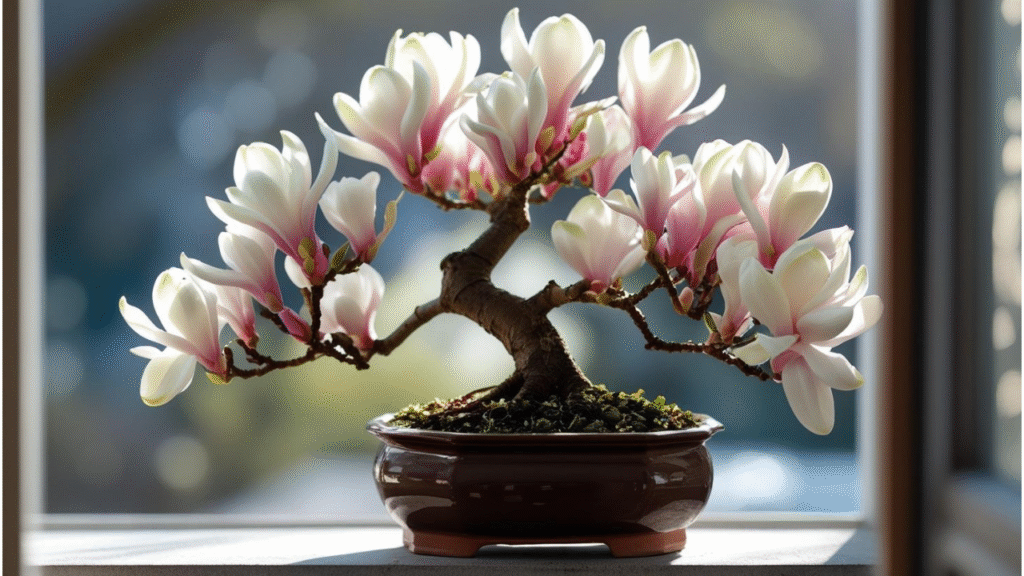
How to Care for a Magnolia Bonsai Tree: Essential Tips for Healthy Growth
Magnolia bonsai trees are not just a beautiful addition to any home; they are a statement of elegance and tranquility. 🌸 But here’s the challenge: caring for a magnolia bonsai tree requires more than just basic plant care. Unlike regular bonsai trees, magnolia varieties have specific needs for sunlight, water, soil, and pruning that, if neglected, can hinder their growth and beauty. 🌱
If you’re wondering how to keep your magnolia bonsai tree thriving and blooming year after year, you’re in the right place. In this guide, we’ll walk you through all the essential care tips—from watering and pruning to preventing common issues—ensuring your bonsai not only survives but flourishes. Whether you’re a beginner or a seasoned plant enthusiast, these expert tips will help you build a deeper connection with your magnolia bonsai tree and turn your space into a stunning floral oasis. Keep reading to unlock the secrets to a healthy, happy magnolia bonsai! 😊
Table of Contents
Toggle🌸 What is a Magnolia Bonsai Tree? 🌸
A magnolia bonsai tree 🌳 is a miniature version of the majestic magnolia tree 🌿, sculpted and nurtured through the art of bonsai 🪴. Known for its striking, large blossoms 🌸 and elegant appearance 🌷, the magnolia bonsai brings the beauty of this iconic tree 🌳 into a compact, manageable form that thrives in containers 🪴.
Unlike typical bonsai 🌿, magnolia bonsai trees 🌳 are particularly cherished for their stunning flowers 🌸, which can range in color from white 🤍 and pink 💖 to purple 💜. These trees 🌳 symbolize strength 💪, beauty ✨, and resilience 🌱, making them a perfect addition to any garden 🌿 or indoor space 🏡.

Growing a magnolia bonsai 🌳 involves more than just pruning ✂️—it’s about creating a tree 🌱 that maintains its unique characteristics in a small pot 🪴. The result is a delightful mix of natural elegance 🌿 and artistry 🎨 that adds a touch of sophistication wherever it’s placed 🌟. Whether you’re a beginner 🌱 or experienced bonsai enthusiast 🧑🌾, understanding the essence of magnolia bonsai trees 🌳 will help you care for them in the best possible way! 🌿🌸
🌞 Choosing the Right Location for Your Magnolia Bonsai Tree 🌞
The location you choose for your magnolia bonsai tree 🌳 is crucial to its overall health 🏥 and growth 🌱. Finding the perfect spot will ensure your tree thrives 🌿, blooms beautifully 🌸, and stays vibrant for years to come. Here’s what you need to consider when selecting the ideal location:
🏠 Indoor vs. Outdoor 🏠
- Indoor: If you plan to keep your magnolia bonsai indoors 🏡, place it in a spot where it can receive plenty of bright, indirect sunlight ☀️. Avoid direct sunlight 🌞, as it can scorch the delicate leaves 🍃. A windowsill facing east or west 🪟 is ideal.
- Outdoor: If you’re lucky enough to live in a climate where magnolia trees 🌳 thrive, you can keep your bonsai outside 🌳. Magnolia bonsai trees 🌿 love full sun 🌞 and will benefit from spending time outdoors during warmer months 🌸. Ensure it’s sheltered from strong winds 🌬️ and extreme temperatures 🥶.
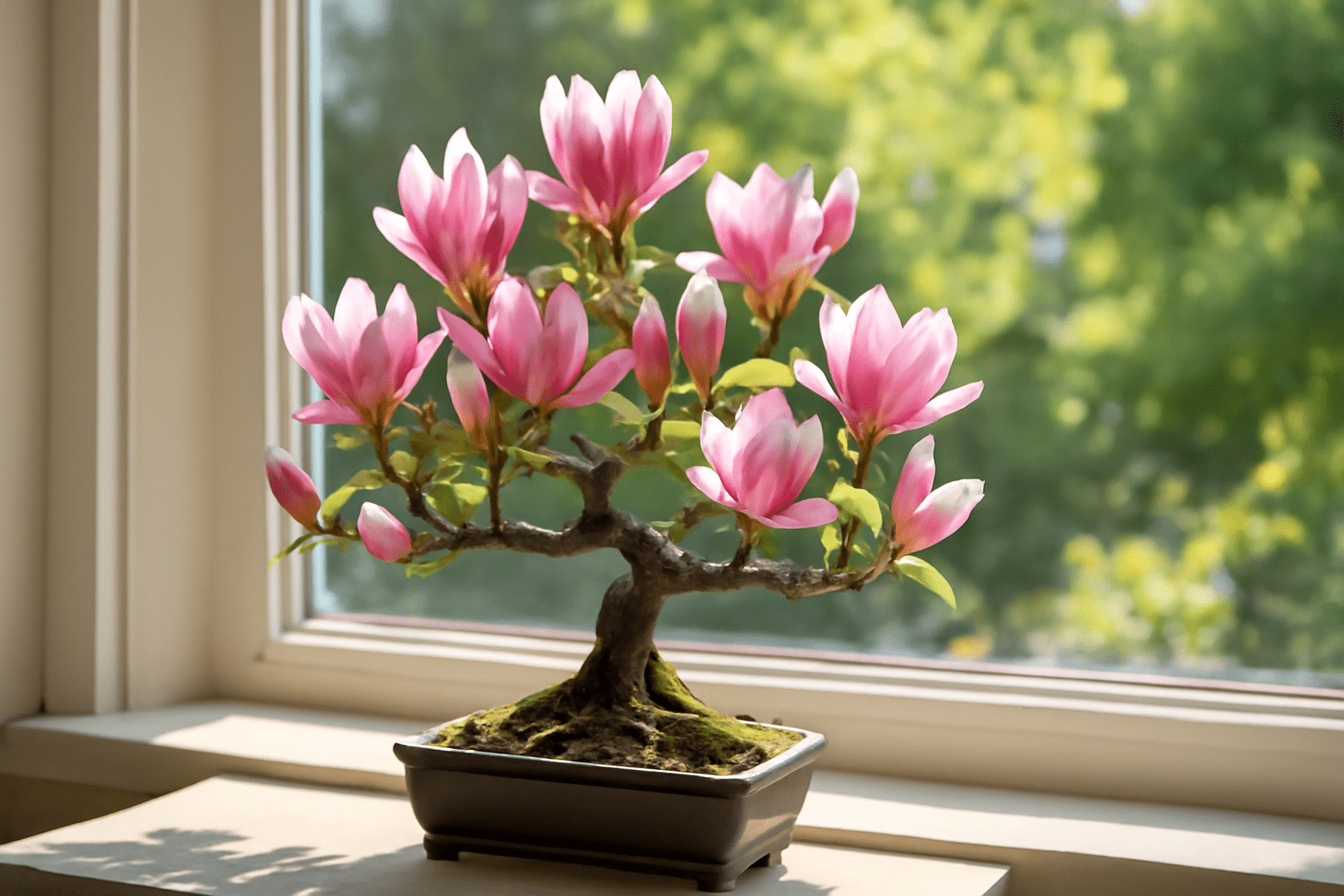
🌡️ Temperature Considerations 🌡️
Magnolia bonsai trees 🌳 prefer temperate climates 🌤️ with temperatures ranging from 50°F to 80°F (10°C to 27°C). They do not tolerate frost 🥶 well, so if you’re growing your tree 🌳 outdoors, bring it inside 🏡 when temperatures drop in the fall 🍂 and winter ❄️.
💧 Humidity Needs 💧
Magnolia bonsai trees 🌳 thrive in higher humidity environments 💧. If you’re keeping your tree indoors 🏠, you can place it on a humidity tray 🌿 or use a humidifier nearby 🌬️. Regular misting 💦 also helps replicate the natural moisture magnolias love 🌱. Just be careful not to overdo it, as excess moisture 💧 can lead to mold 🦠.
🌞 Lighting Needs 🌞
Magnolia bonsai trees 🌳 require a minimum of 4-6 hours of direct sunlight 🌞 each day to grow strong 💪 and produce beautiful blooms 🌸. If indoors 🏡, place your tree 🌳 near a window 🪟 that gets ample sunlight ☀️. If outdoors 🌳, ensure your tree gets plenty of sun exposure ☀️ throughout the day 🌱 to encourage blooming 🌷 and healthy growth 🌿.
Choosing the right location isn’t just about where the tree 🌳 looks best—it’s about ensuring it gets the light 🌞, temperature 🌡️, and humidity 💧 it needs to flourish 🌱. Keep these tips in mind, and your magnolia bonsai 🌳 will thank you with stunning flowers 🌸 and healthy growth 🌿!
💧 Watering Your Magnolia Bonsai Tree 💧
Proper watering 💦 is one of the most important aspects of caring for your magnolia bonsai tree 🌳. Too little or too much water can lead to stress 😓, affecting the tree’s growth 🌱 and health 🏥. Here’s how to get it just right:
🌱 How Often Should You Water? 🌱
Magnolia bonsai trees 🌳 prefer to have their soil 🌍 kept consistently moist 🌿, but never waterlogged 💧. To check when it’s time to water 💦, stick your finger 👆 about an inch into the soil 🌱. If it feels dry 🌾, it’s time to water 💧. If it’s still moist 🌱, wait a day or two ⏳ before checking again.
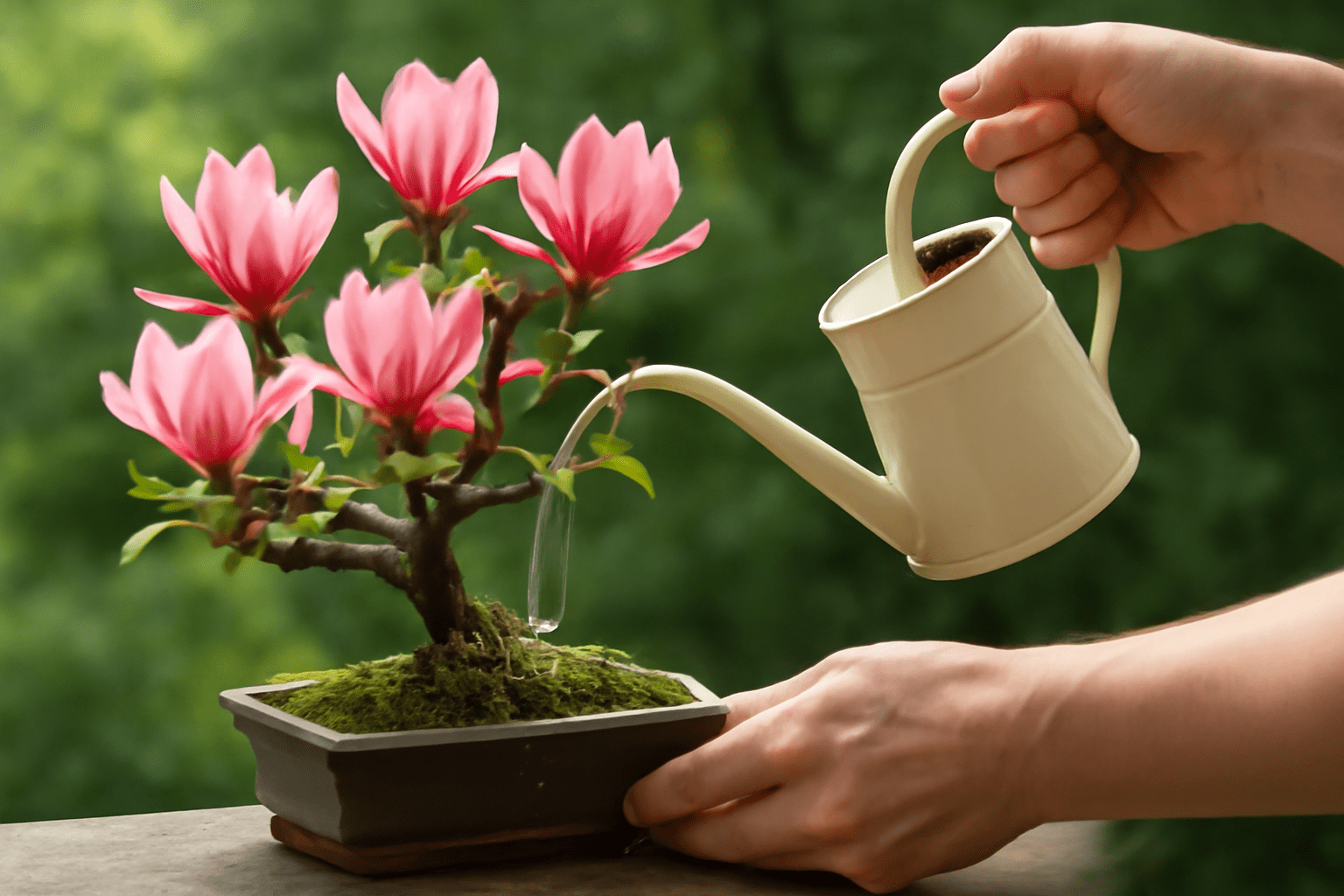
💦 Watering Best Practices 💦
- Thorough Watering 💧: Always water the tree 🌳 evenly until the water 🌊 flows out from the drainage holes at the bottom of the pot 🪴. This ensures the roots 🌱 are properly hydrated 💧.
- Gentle Watering 🌸: Use a watering can with a fine spout 🪣 or a spray bottle 💧 to gently water your magnolia bonsai 🌳. This avoids disturbing the soil 🌍 or damaging the delicate roots 🌱.
🌟 Signs of Overwatering or Underwatering 🌟
- Overwatering 💦: Yellowing leaves 🍃, root rot 🦠, or a musty smell 🦠 from the soil 🌱 are all signs of overwatering 💧. Make sure your bonsai’s pot 🪴 has good drainage 🌊 and that the soil 🌱 isn’t staying soggy.
- Underwatering 🌵: Dry, crispy leaves 🍂 or wilting 🌱 are often signs your tree 🌳 is thirsty 💧. Ensure you’re watering 💦 regularly to keep the soil 🌿 evenly moist, but not drenched 💧.
🏖️ How to Prevent Water Stress 🏖️
To help your magnolia bonsai 🌳 thrive 🌱, make sure it’s in a well-draining soil mix 🌱. This allows excess water 💧 to escape, reducing the risk of root rot 🦠. Using a pot 🪴 with drainage holes 🌊 is also essential to prevent water 💦 from collecting at the bottom.
Getting the watering 💦 right can make all the difference in your magnolia bonsai’s growth 🌿. Regular, careful watering 💧 will help your tree 🌳 stay healthy 🌱 and vibrant 🌸, with lush leaves 🍃 and beautiful blooms 🌸 to admire.
🌿 Soil and Fertilizing Your Magnolia Bonsai Tree 🌿
The right soil 🌱 and proper fertilization 🧴 are essential to keeping your magnolia bonsai tree 🌳 healthy, strong 💪, and blooming beautifully 🌸. Here’s everything you need to know about choosing the best soil 🏡 and fertilizer 🧴 for your tree:
🌱 Choosing the Right Soil 🌱
Magnolia bonsai trees 🌳 thrive in well-draining soil 🌿 that allows water 💧 to pass through easily while retaining just enough moisture for the roots 🌱. Here’s what to look for in soil 🌍:
- Well-draining mix 🌊: Use a mix that includes akadama, pumice, and lava rock for excellent drainage 🌱.
- Slightly acidic soil 🍂: Magnolias 🌳 prefer soil 🌱 that is slightly acidic, with a pH between 6.0 and 7.0. Avoid overly rich or heavy soils that retain too much water 💧.
- Airy texture 🌾: The soil should be light and airy to allow for healthy root development 🌱.
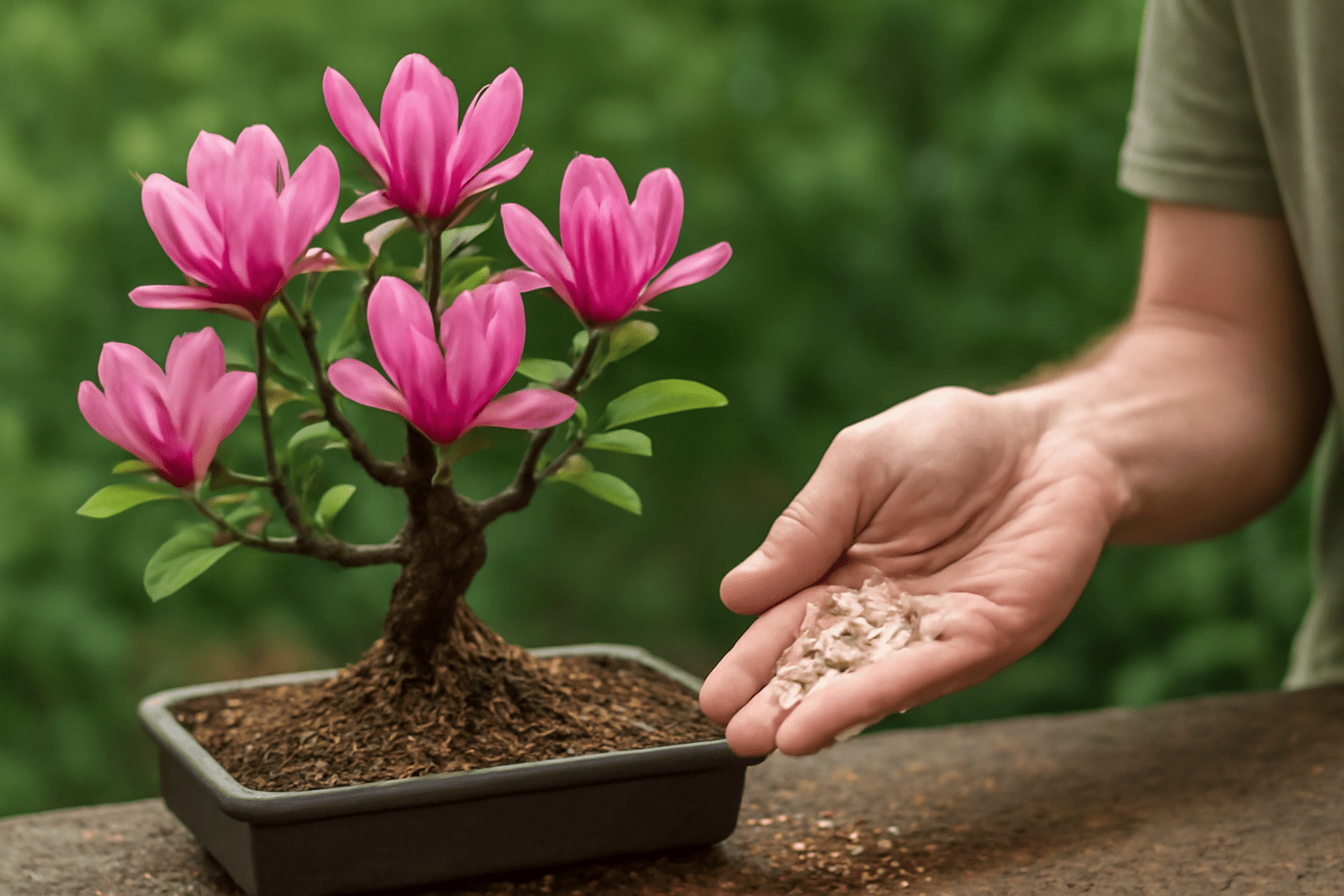
🧴 Fertilizing Your Magnolia Bonsai Tree 🧴
Fertilizing 🧴 helps provide the nutrients 🌱 your magnolia bonsai tree 🌳 needs to grow strong 💪 and produce beautiful blooms 🌸. Here’s how to get it right:
When to Fertilize:
- Spring 🌷 and summer 🌞 are the active growing seasons, so fertilize regularly 💧 to support healthy growth 🌱.
- Fall 🍂 and winter ❄️: Reduce or stop fertilizing as the tree enters its dormant phase 💤.
Best Type of Fertilizer 🧴:
- Use a balanced, slow-release fertilizer 🧴 with equal parts of nitrogen (N), phosphorus (P), and potassium (K) 🌱. This supports both leaf growth 🍃 and root development 🌱.
- Alternatively, you can use organic fertilizers 🌱 like fish emulsion 🐟 or compost 🌿, which release nutrients slowly.
How to Apply 💧:
- For slow-release fertilizers 🧴, apply according to the package instructions 📊, typically every 4-6 weeks during the growing season 🌱.
- If using liquid fertilizer 💧, dilute it to half strength to avoid over-fertilizing 🚫. Apply once a month during the growing season 🌸.
🌸 Signs Your Tree Needs Fertilization 🌸
- Yellowing leaves 🍂 or stunted growth 🌱 may indicate a nutrient deficiency ❌.
- Leggy growth 🌱 with sparse leaves 🍃 could mean the tree isn’t getting enough phosphorus (P) or potassium (K).
💡 Tips for Healthy Soil and Fertilizing 💡
- Repotting 🪴: Repot your magnolia bonsai 🌳 every 2-3 years to refresh the soil 🌱 and ensure that the roots 🌱 have plenty of space to grow 🌳.
- Avoid Overfertilizing 🚫: Too much fertilizer 🧴 can burn the roots 🌱 and cause poor growth 🌿. Stick to the recommended amounts and avoid fertilizing when the tree is dormant 💤.
By using the right soil mix 🌱 and applying appropriate fertilizers 🧴, you’ll provide your magnolia bonsai tree 🌳 with the nutrients it needs to grow strong 💪, produce vibrant blooms 🌸, and stay healthy year-round 🌿.
✂️ Pruning and Shaping Your Magnolia Bonsai Tree ✂️
Pruning ✂️ and shaping your magnolia bonsai tree 🌳 are key 🔑 to maintaining its aesthetic beauty ✨ and overall health 🌱. Regular pruning helps the tree 🌳 maintain its miniature size 🌿 and encourages the growth of healthy, well-structured branches 🌱. Here’s how to do it right:
🌿 Why Pruning is Essential 🌿
Pruning your magnolia bonsai 🌳 isn’t just about appearance 🌸—it’s essential for maintaining a balanced shape ⚖️ and promoting healthy growth 🌱. Proper pruning ✂️:
- Encourages strong branching 🌿: Helps the tree 🌳 develop a well-rounded canopy 🌳 and fuller branches 🌱.
- Improves air circulation 🌬️: Ensures that light ☀️ and air 🌬️ reach all parts of the tree 🌳, reducing the risk of pests 🦠 and disease 🦠.
- Removes dead or damaged wood 🍂: Helps the tree 🌳 stay healthy by removing any weak or decaying branches 🍂.
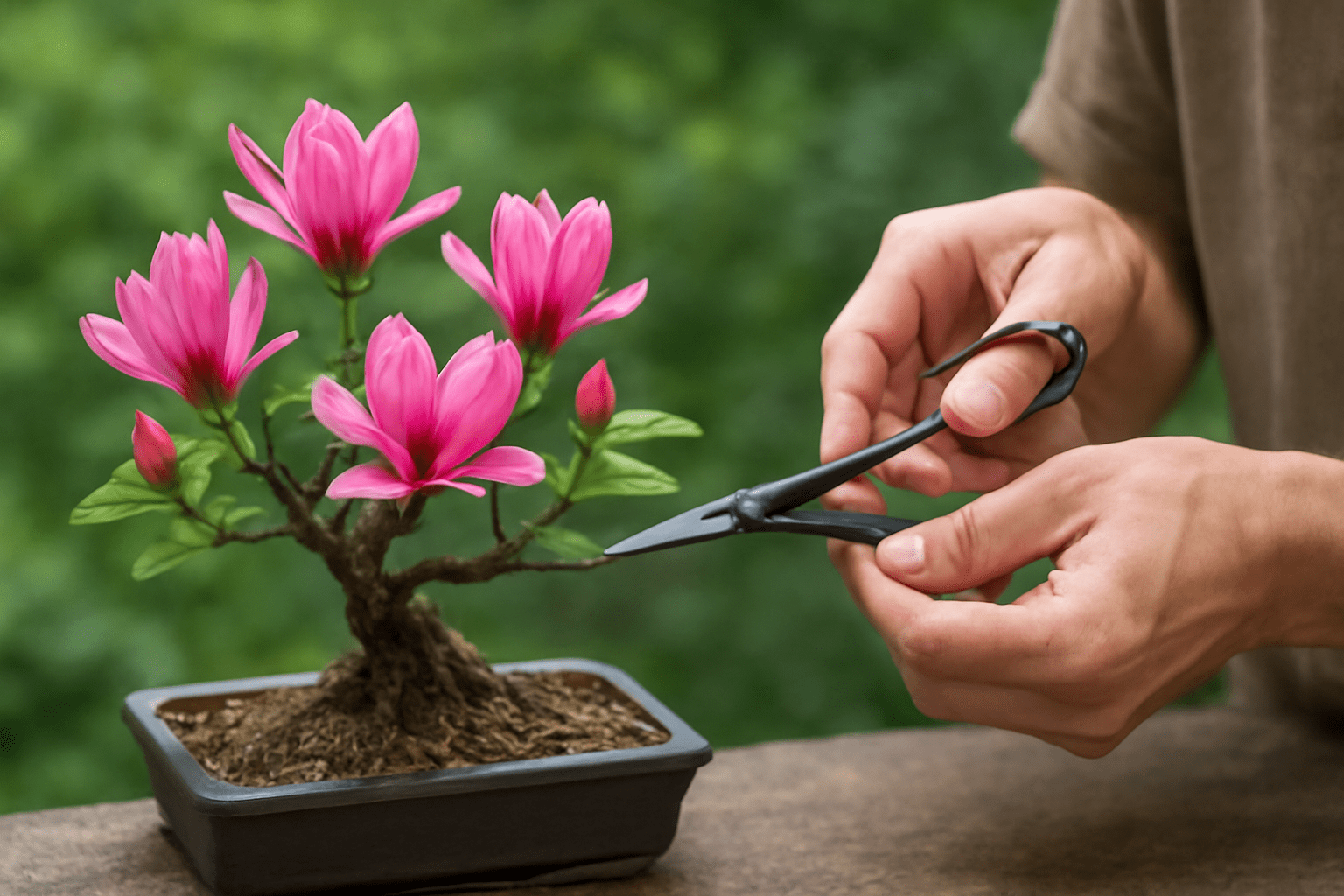
🕒 When to Prune Your Magnolia Bonsai Tree 🕒
- Best Time to Prune ⏰: The ideal time 🕓 to prune is during early spring 🌸, just before the tree 🌳 begins its active growing season 🌱. This allows the tree 🌳 to heal quickly 💨 and produce new growth 🌿.
- Avoid Pruning During Blooming 🌷: Try not to prune ✂️ when your magnolia bonsai 🌳 is blooming 🌸. Pruning during this time ⏳ can harm the flowers 🌸 and reduce the overall bloom quality 💐.
✂️ How to Prune Your Magnolia Bonsai Tree ✂️
- Remove Dead or Diseased Branches 🍂: Start by cutting away any dead, broken, or diseased branches 🍂 to prevent infection 🦠 and improve overall health 🌱.
- Thin Out the Tree 🌳: Prune the inner branches 🌿 to allow better airflow 🌬️ and light penetration ☀️ to the core of the tree 🌳. This helps keep the tree 🌳 balanced ⚖️ and supports healthy growth 🌱.
- Cut Back to Shape 🌸: Trim the tips of long, unruly branches 🌿 to maintain a well-rounded shape 🌱. Magnolia bonsai trees 🌳 should have a natural, flowing look 🌳, so avoid over-pruning 🚫 to maintain their delicate structure 🌸.
- Pinch New Shoots 🌿: Pinching back new shoots ✂️ will encourage the growth of lateral branches 🌱, making the tree 🌳 bushier and denser.
🌟 Techniques for Shaping Your Magnolia Bonsai Tree 🌟
- Wiring 🪢: Use bonsai wire 🧶 to shape branches 🌳 and create your desired tree form 🌱. Gently wrap the wire around the branches 🌿 and bend them to your liking 🌸. Be cautious not to wire too tightly 🔒, as this can damage the bark 🌳.
- Selective Pruning ✂️: Focus on removing branches 🌿 that are crossing or growing inward ↔️. Always prune selectively 🧑🌾 to enhance the natural form 🌳 of the tree 🌿.
⚠️ Tips for Successful Pruning ⚠️
- Use Sharp Tools ✂️: Always use clean, sharp pruning shears ✂️ or scissors ✂️ to ensure smooth cuts ✂️ and avoid damaging the branches 🌳.
- Prune Gradually ⏳: Don’t remove too much at once—pruning a little at a time helps maintain the balance ⚖️ of the tree 🌳.
- Don’t Over-Prune 🚫: Avoid cutting back too much, as it may stress the tree 🌳. Magnolia bonsai trees 🌳 should have a balanced structure 🌿, so prune with care ❤️.
Regular pruning ✂️ and shaping 🌳 will help your magnolia bonsai tree 🌳 grow into a beautiful 🌸, healthy 🌿, and well-structured miniature version of its larger counterpart 🌳. By following these tips 💡, you’ll ensure that your tree 🌳 stays vibrant 🌸 and full of life 🌱, with stunning blooms 🌸 and a graceful, elegant shape 🌿.
🌿 Repotting Your Magnolia Bonsai Tree 🌿
Repotting is an essential part of caring for your magnolia bonsai tree. 🌳 Over time, the soil can become compacted, and the roots may outgrow the pot, affecting the tree’s health. 🌱 Regular repotting ensures your bonsai has the space and nutrients it needs to thrive. 🌸 Here’s how to do it right:
🕰️ When to Repot Your Magnolia Bonsai Tree 🕰️
- Repotting Frequency: Magnolia bonsai trees should be repotted every 2-3 years, depending on how quickly the roots grow. 🌱 Younger trees may need repotting more often, while older trees can go longer between repots. 🌳
- Best Time to Repot: The ideal time to repot is early spring, just before the growing season begins. 🌷 This minimizes the stress on the tree and gives it time to recover and adjust to its new pot. 🪴
🧳 How to Repot Your Magnolia Bonsai Tree 🧳
- Step 1: Remove the Tree: Gently remove the magnolia bonsai from its current pot. 🌱 Be careful not to damage the roots during this process. 🌿 You can gently tap the pot to loosen the tree if it’s stuck. 🪴
- Step 2: Trim the Roots: Carefully trim the roots, removing any that are overly long or circling the pot. 🌳 Trim about 1/3 of the roots to encourage new, healthy growth. 🌱 If you notice any dead or rotting roots, cut them away. ✂️
- Step 3: Prepare the New Pot: Choose a pot that is slightly larger than the current one. 🏺 Ensure it has drainage holes to prevent water buildup, which can lead to root rot. 🌿 Add a layer of drainage material at the bottom (e.g., gravel or mesh) to further improve drainage. 🌊
- Step 4: Add Fresh Soil: Fill the bottom of the pot with fresh, well-draining bonsai soil. 🌱 Carefully place the tree into the pot and add more soil around the roots, making sure the tree is centered and stable. 🌳 Gently tap the pot to settle the soil. 🌿
- Step 5: Water Thoroughly: After repotting, water the magnolia bonsai thoroughly to help settle the soil and hydrate the roots. 💧 Ensure the water drains freely from the pot. 🌊
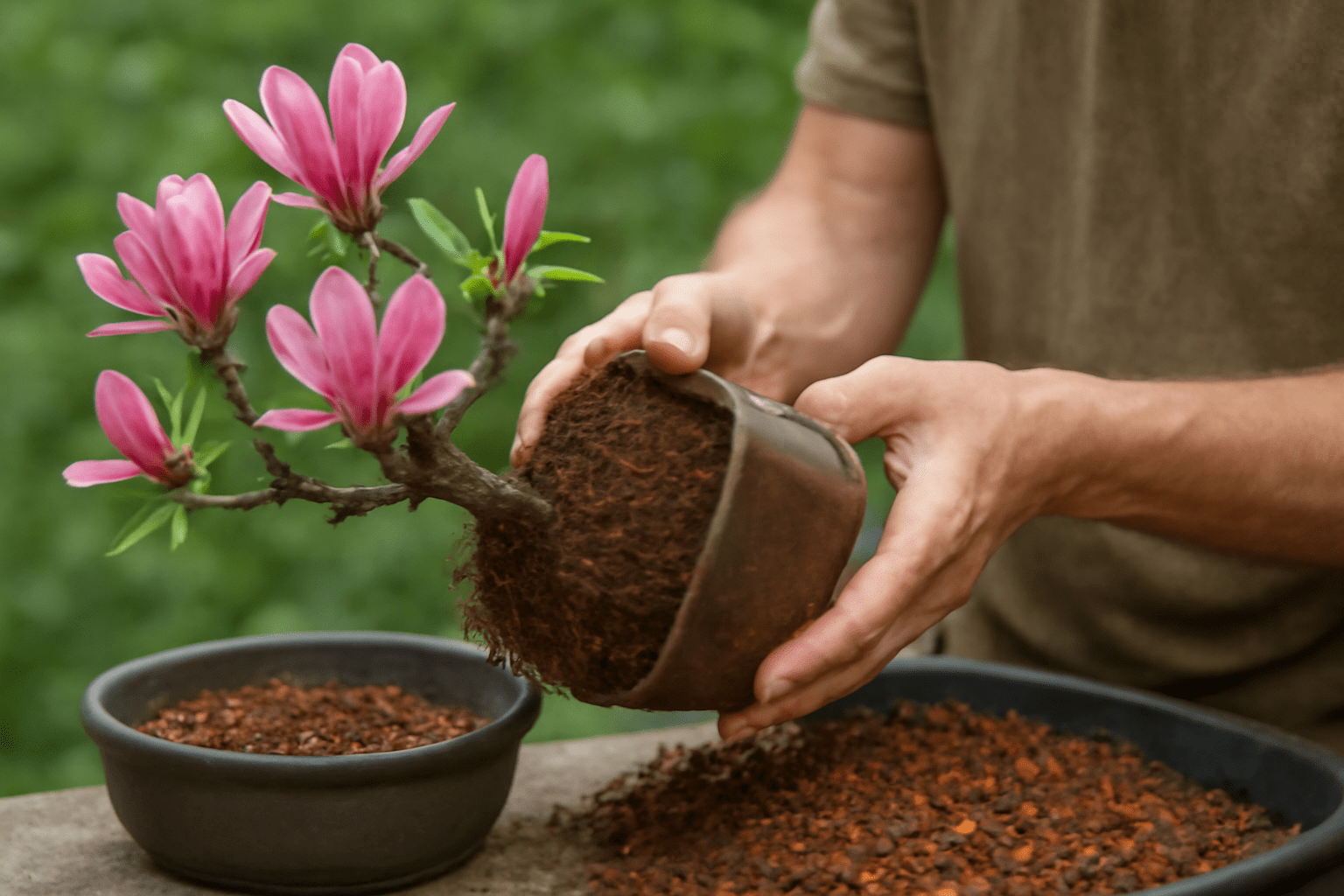
🌿 Signs It’s Time to Repot 🌿
- Roots Growing Out of Drainage Holes: If you notice roots poking out from the bottom of the pot, it’s a clear sign that your tree has outgrown its pot and needs a larger space. 🌱
- Stunted Growth: If the magnolia bonsai seems to stop growing or becomes weak, it may be struggling with compacted soil or restricted roots. 🌿
- Soil Breakdown: Over time, the soil will lose its structure and become less effective at draining water. 💧 If the soil looks compacted or is holding too much water, it’s time to repot. 🌱
💡 Tips for Successful Repotting 💡
- Use Clean Tools: Make sure your pruning shears or scissors are clean and sharp to avoid introducing disease during the repotting process. ✂️
- Avoid Pruning Too Much: While trimming the roots, don’t go overboard. ⚠️ Only remove the necessary amount of roots to keep the tree healthy. 🌱
- Water After Repotting: After repotting, place your bonsai in a shaded area for a few days to help it recover. 🌿 Water it regularly but avoid direct sunlight until the tree shows signs of new growth. 🌱
Repotting your magnolia bonsai tree may seem daunting, but it’s a simple process that will pay off in the long run. 🌿 By giving your bonsai the space and nutrients it needs, you’ll encourage strong growth, vibrant blooms, and a healthier tree overall. 🌸
⚠️ Common Problems and How to Solve Them ⚠️
While magnolia bonsai trees are relatively easy to care for, they can face a few common issues. 🌱💧 Understanding these problems and knowing how to address them will help keep your tree healthy and thriving. 💪🌿 Here are the most frequent problems you might encounter with your magnolia bonsai—and how to solve them:
🌿 1. Yellowing Leaves 🌿
Problem: Yellowing leaves 🍃 are a sign that something is wrong ⚠️. It could be caused by overwatering, underwatering, or a nutrient deficiency. 🧪💦
Solution:
- Overwatering: 🚿 Ensure the soil is well-draining 🌾 and avoid letting the pot sit in excess water. 💧❌ Always let the top layer of soil dry out before watering again ☀️.
- Underwatering: 😓 If the leaves turn yellow and dry out, it may be a sign that your bonsai is thirsty 🥤. Increase the watering frequency 🔁, but always water thoroughly 💦🌸.
- Nutrient Deficiency: 🌿 Yellowing can also indicate a lack of nutrients 🍽️. If you haven’t been fertilizing regularly, try applying a balanced fertilizer during the growing season 🌞🌱 to correct the deficiency.

🐞 2. Pests (Aphids, Scale, or Spider Mites) 🐞
Problem: Pests such as aphids 🐜, scale 🛡️, and spider mites 🕷️ can damage the leaves and stems of your magnolia bonsai tree 🌳. These tiny invaders can cause leaf curling, wilting, and discoloration 😟.
Solution:
- Remove Pests Manually: ✋ Use a soft cloth or cotton swab dipped in rubbing alcohol 🍶 to wipe off visible pests 🧼👀.
- Insecticidal Soap: 🧴 Spray your bonsai with insecticidal soap 🫧 or a natural solution like neem oil 🌿 to combat infestations. Make sure to treat both the top and underside of the leaves 🍃🔍.
- Regular Inspection: 👁️ Keep an eye on your tree regularly 🔄, especially during the warmer months ☀️ when pests are more active 🐛.
🌱 3. Root Rot 🌱
Problem: Root rot 🦠 occurs when the roots of the magnolia bonsai are kept in too much water 💦, causing them to decay 🤢. This can lead to wilting 😞, yellowing 🍂, and even the death of the tree ⚰️.
Solution:
- Check Drainage: ✔️ Ensure your pot has adequate drainage holes 🕳️ and that excess water can escape 💧.
- Adjust Watering Routine: 📅 Water the tree only when the top inch of soil is dry to the touch ☝️🌾. Avoid letting the pot sit in water 🚫🪣.
- Repot and Trim: 🔄 If you notice root rot, repot the bonsai immediately 🚨. Trim away any rotting roots ✂️🧱, and refresh the soil with a well-draining bonsai mix 🪴🪨.
🍂 4. Leaf Drop 🍂
Problem: Losing leaves 🍁, especially in the growing season 🌱, can be a sign of stress 😖 due to improper care, environmental changes 🌡️, or pests 🐜.
Solution:
- Environmental Stress: 🏠 If you’ve recently moved your bonsai or changed its location 📦, it may be stressed. Try to place it back in its previous location 🧭 or a spot with consistent light and temperature ☀️🌡️.
- Pest Infestation: 🧐 Check for any pests like aphids or spider mites that may be causing damage. Treat with insecticidal soap if needed 🫧💪.
- Watering Issues: 💦 Both overwatering and underwatering can cause leaf drop 🍃. Make sure your watering schedule is consistent 📆 and appropriate for your bonsai’s needs 🪴❤️.
🌞 5. Lack of Flowers 🌞
Problem: Magnolia bonsai trees are known for their beautiful blooms 🌸💖, but sometimes they might not flower as expected 😢. This can happen if the tree is stressed 🥺, underfed 🍽️, or in the wrong environment 🌫️.
Solution:
- Sunlight: ☀️ Ensure your bonsai is getting enough sunlight (at least 4–6 hours of direct sunlight per day) 🌞 to promote blooming 🌺.
- Proper Fertilization: 🧪 Use a balanced fertilizer during the growing season to provide the nutrients necessary for flower production 💐🍀.
- Pruning Timing: ✂️ Avoid heavy pruning during blooming season 🗓️, as this can reduce the tree’s ability to flower 🚫🌸.
💡 Tips for Preventing Problems 💡
- Proper Care: 🌿 Stick to a consistent watering schedule 🗓️💧, and use the right soil mix 🪨 to avoid common problems like root rot 🧼.
- Check Regularly: 👀 Regularly inspect your magnolia bonsai for pests 🐛, disease 🦠, and signs of stress 😰. Early detection 🔍 makes it easier to solve any problems quickly 🛠️.
- Maintain a Stable Environment: 🌞🌬️ Keep your bonsai in a location with consistent temperature 🌡️, humidity 💧, and light ☀️ to prevent environmental stress.
By recognizing these common problems early 🕵️♀️ and taking proactive measures 🛡️, you can ensure your magnolia bonsai tree remains healthy and beautiful 🌳✨. With a little care and attention 🥰, your bonsai will continue to thrive, bloom 🌼, and bring joy to your home or garden 🏡💚. 🌸🌿
🌸 Magnolia Bonsai Tree Blooming Tips 🌸
Getting your Magnolia Bonsai Tree to bloom is one of the most rewarding aspects of its care, but it can be a bit tricky. With the right tips and techniques, you’ll be able to encourage beautiful blossoms year after year. Here’s a simple guide to help you succeed. 🌿🌼
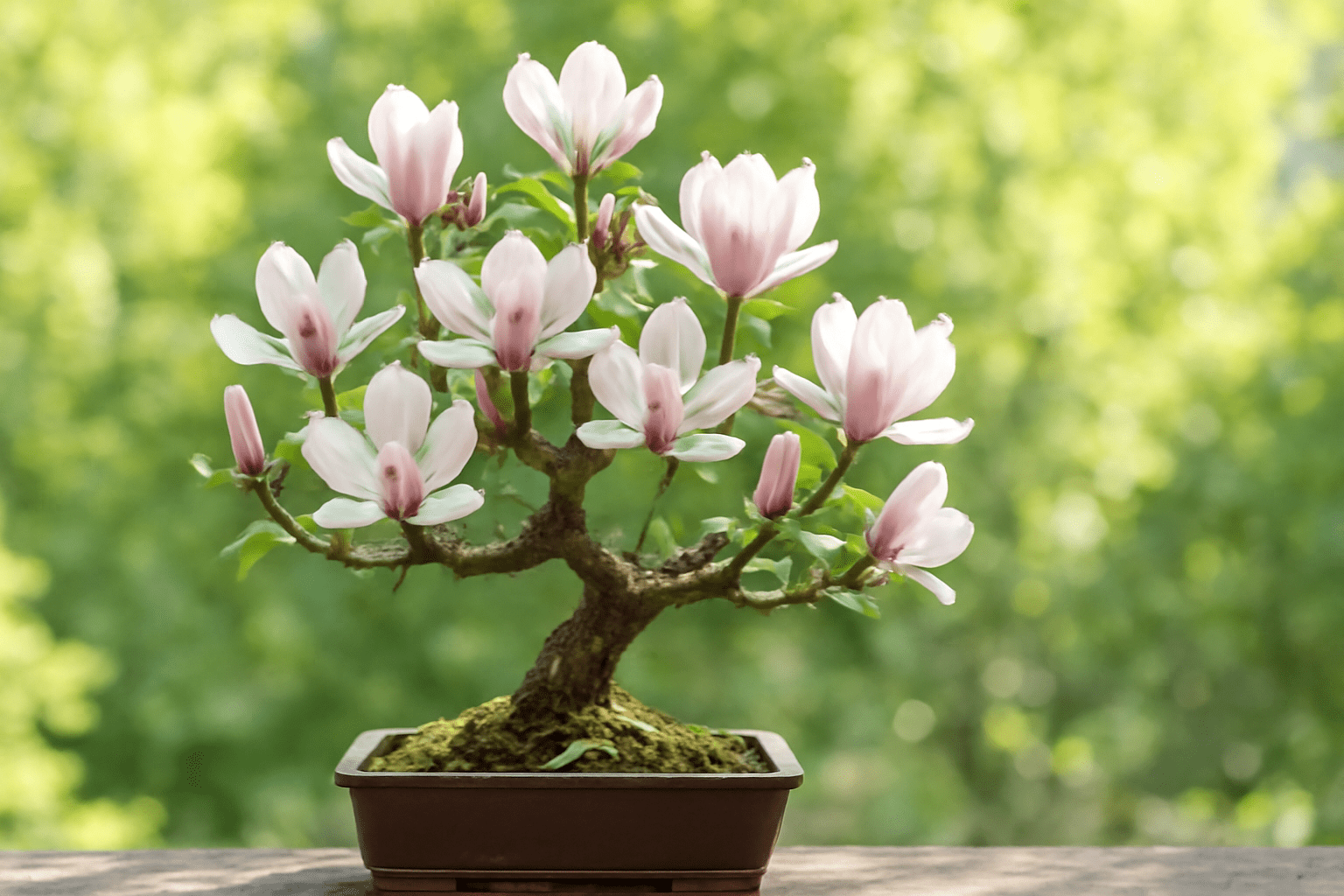
☀️ 1. Provide Plenty of Sunlight ☀️
Magnolias love sunlight! To encourage healthy blooms, place your bonsai tree in a spot that receives at least 4 to 6 hours of sunlight a day. A sunny windowsill or a spot on your patio is perfect. 🌞 Light helps the tree produce energy, which is essential for blooming.
🕰️ 2. Be Patient 🕰️
Magnolia bonsai trees can take a while to bloom, especially when they’re younger. Patience is key! It may take a few years for your tree to start producing flowers. If your tree is still young, don’t worry—just keep following the care tips, and the blooms will come in time. 🌷
✂️ 3. Prune Wisely ✂️
Pruning is essential, but be careful not to overdo it. You want to trim away dead or damaged branches to allow the tree to direct its energy toward healthy growth and flowering. Be sure to prune after the blooming season, so you don’t accidentally remove potential buds for the next cycle. 🌳
💧 4. Water Properly 💧
Magnolia bonsais need consistent moisture but don’t like to sit in water. Water the tree when the top layer of soil feels dry, but make sure the pot has proper drainage. Too much water can cause root rot, which hinders blooming. A well-draining bonsai soil mix can help maintain a healthy root system. 💦
🍃 5. Fertilize with Care 🍃
Feeding your magnolia bonsai can make a big difference when it comes to blooming. Use a balanced fertilizer with equal parts nitrogen, phosphorus, and potassium. Apply the fertilizer once a month during the growing season (spring and summer) to encourage healthy buds and blooms. Don’t fertilize in the winter when the tree is dormant. 🌿
🌡️ 6. Maintain Ideal Temperature 🌡️
Magnolias thrive in moderate temperatures. Keep your bonsai in a room that stays between 60°F to 75°F (15°C to 24°C) during the growing season. During the winter months, a slightly cooler environment (around 50°F to 60°F) can help encourage dormancy, which is necessary for next season’s bloom. ❄️
🏺 7. Repot When Necessary 🏺
Over time, your magnolia bonsai will outgrow its pot, and this can affect its ability to bloom. Repot your tree every 2-3 years to ensure it has enough space for root growth and healthy blooms. Choose a pot that’s slightly larger than the current one, and use fresh bonsai soil to help with drainage. 🌱
🌼 8. Encourage Bud Development 🌼
To promote bud formation, make sure the tree has a balanced environment. Avoid moving it too much, as stress can prevent buds from forming properly. In late winter or early spring, you can lightly prune the branches that aren’t forming buds, focusing on the ones that show promise of blooming.
🌺 9. Consider the Right Variety 🌺
Not all magnolia bonsai trees bloom at the same rate. Some varieties are naturally more flower-friendly than others. If you’re looking for a magnolia that flowers more easily, consider varieties like the Magnolia Stellata or Magnolia Soulangeana, which tend to produce more blooms. 🌸
With patience and the right care, your Magnolia Bonsai Tree will reward you with beautiful blooms. 🌷 Remember to give it plenty of sunlight, water appropriately, and prune carefully to support healthy growth and blossoms. Follow these tips, and soon you’ll enjoy your very own miniature magnolia garden! 🌟
🌿 Final Thoughts 🌿
Caring for a Magnolia Bonsai Tree is a rewarding and fulfilling journey that brings beauty and elegance to any space. By following these essential care tips—providing ample sunlight, proper watering, regular pruning, and patience—you’ll set your tree up for healthy growth and stunning blooms. 🌸
Remember, bonsai care is all about balance: too much or too little of something can hinder progress, so always keep an eye on your tree’s needs. Whether you’re a beginner or an experienced gardener, the joy of nurturing your Magnolia Bonsai and watching it thrive is well worth the effort. 🌿

Stay consistent, be patient, and with time, you’ll see the magical transformation of your little tree into a stunning miniature masterpiece! 🌱😊
Happy bonsai gardening! 🌷🌟
Frequently Asked Questions (FAQs)
How often should I water my Magnolia Bonsai tree? 💧
Water your Magnolia Bonsai when the top layer of soil feels dry to the touch. Typically, this means watering every 2-3 days in warmer months and less frequently in the winter when the tree is dormant. Ensure the pot has good drainage to avoid waterlogging and root rot. 🌱
How much sunlight does a Magnolia Bonsai need? 🌞
Magnolia Bonsai trees require 4 to 6 hours of direct sunlight daily. Place your tree in a bright spot, such as a south-facing window, to help it thrive. If you’re keeping it indoors, consider using a grow light if natural sunlight is insufficient. 🌸
When does a Magnolia Bonsai bloom? 🌷
Magnolia Bonsai trees typically bloom in early spring, although younger trees may take a few years to flower. With proper care, you’ll start to see beautiful blossoms once the tree is mature enough and has received enough sunlight and nutrients. 🌿
What type of soil is best for Magnolia Bonsai? 🌱
A well-draining soil mix is essential for Magnolia Bonsai trees. Use a bonsai-specific soil or create a mix with components like akadama, pumice, and lava rock. This ensures good drainage and helps prevent root rot. 🏺
How do I prune my Magnolia Bonsai tree? ✂️
Prune your Magnolia Bonsai tree by removing dead or damaged branches, and thin out areas to improve airflow and light penetration. Always prune after blooming to avoid cutting off next season’s buds. Be cautious not to over-prune, as this can stress the tree. 🌳
Why isn’t my Magnolia Bonsai blooming? 🌸
If your Magnolia Bonsai isn’t blooming, it could be due to insufficient sunlight, improper watering, or too much fertilizer. Ensure your tree gets enough sunlight, and check that the soil isn’t too dry or too wet. Additionally, be patient; younger trees take longer to bloom. 🌿
Can I keep my Magnolia Bonsai indoors? 🏠
Yes, Magnolia Bonsai trees can be kept indoors, but they still need access to sunlight. Choose a sunny spot like a south-facing window or use grow lights to supplement. Ensure the room temperature stays between 60°F to 75°F for the best growth. 🌞
How do I encourage blooming on my Magnolia Bonsai? 🌼
To encourage blooming, make sure your tree gets plenty of sunlight, water correctly, and is not overfed. Prune carefully to remove unhealthy branches and promote healthy growth. Additionally, ensure the tree has a dormant period during the winter to trigger next season’s bloom. 🌿
